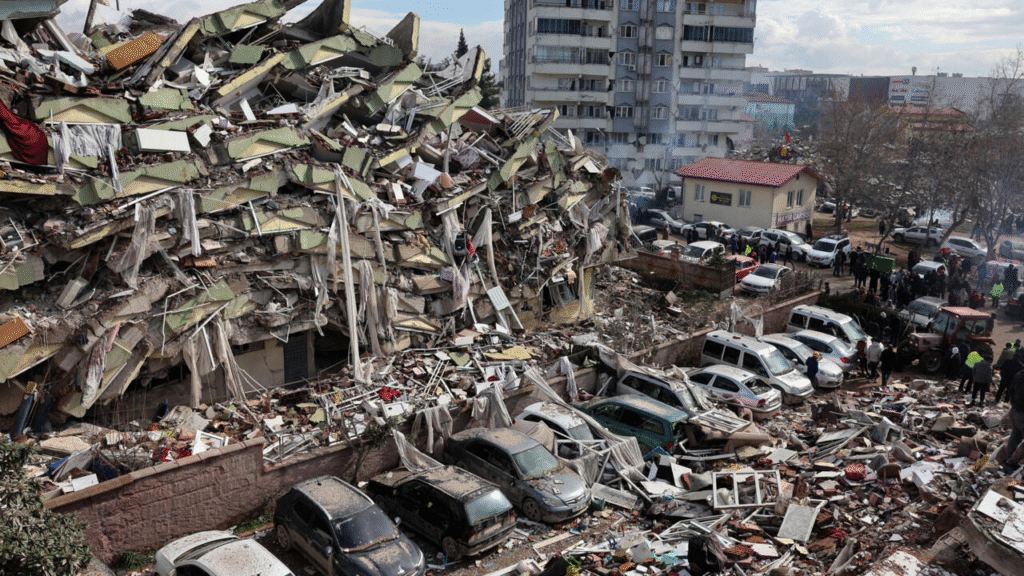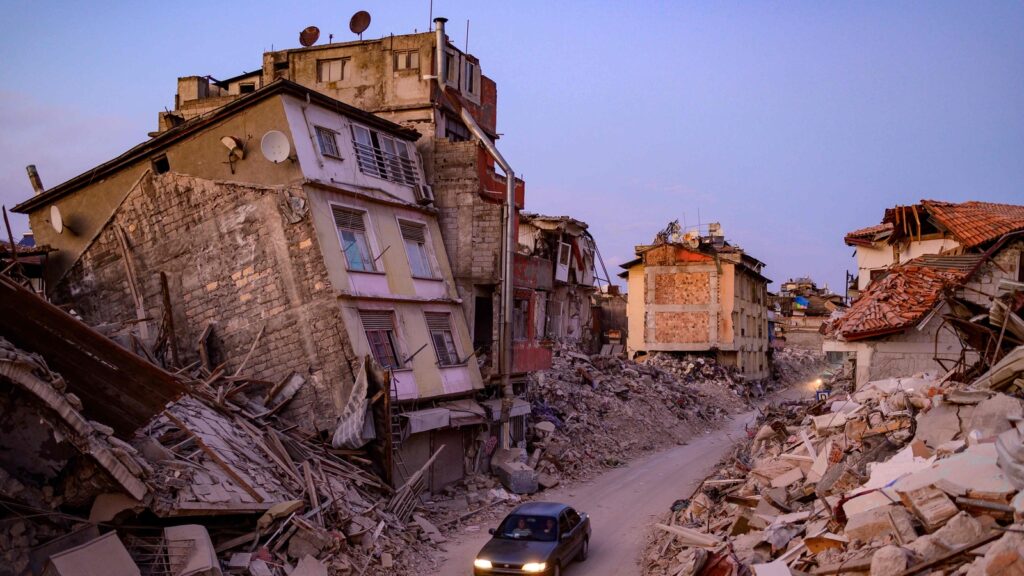
On a seemingly ordinary day, the ground beneath parts of Turkey began to tremble as a significant earthquake registering a magnitude of 5.1 on the Richter scale struck the region. The seismic event sent waves of shock not only through the physical landscape but also deeply affected the psyche of the people living in the affected areas. This earthquake, though moderate compared to some of Turkey’s more catastrophic events in history, serves as a critical reminder of the persistent natural threats that this nation faces due to its unique geological position.
Understanding the Earthquake: Timeline and Immediate Effects
The earthquake occurred on [exact date], originating near [precise epicenter location], at a depth of approximately [depth] kilometers beneath the earth’s surface. The shallow depth of the quake significantly amplified the shaking felt on the surface, causing a noticeable rumbling across several provinces. From the bustling streets of Istanbul to quieter rural areas, residents experienced the earth’s powerful vibrations, some describing the sensation as a rolling wave or a sudden jolt that lasted for several seconds.
Immediately following the quake, emergency services were mobilized swiftly. Turkish Disaster and Emergency Management Authority (AFAD) reported the event and began dispatching rapid response teams to assess damages, assist local authorities, and aid any individuals potentially trapped or injured. While early assessments indicate there were no confirmed fatalities, the earthquake did result in structural damage to buildings—particularly older, less earthquake-resistant structures—cracks in walls, and minor infrastructure disruptions.
The power of this tremor was such that many residents fled their homes and workplaces out of precaution, opting to stay in open spaces until aftershocks subsided. Schools across affected regions were temporarily closed to ensure student safety, and public transportation systems implemented safety checks before resuming normal operations.
Turkey’s Geological Context: Why Earthquakes Are Inevitable
To fully grasp the significance of this earthquake, one must understand Turkey’s complex geological makeup. Straddling the juncture of the Eurasian, Arabian, and African tectonic plates, Turkey exists at a highly volatile intersection of Earth’s crustal movements. The most significant faults in this region include the North Anatolian Fault (NAF), the East Anatolian Fault (EAF), and the Hellenic Arc in the south.
The North Anatolian Fault, stretching over 1,200 kilometers across northern Turkey, has a notorious history of producing devastating earthquakes. It has been responsible for some of the most destructive seismic events in Turkey’s modern history, including the catastrophic 1999 İzmit earthquake, which resulted in over 17,000 deaths and widespread destruction. The East Anatolian Fault, although less active than the NAF, also poses substantial risk and has generated several strong earthquakes over the decades.
This intricate fault network is constantly under strain from the movement of these tectonic plates, making earthquakes an unavoidable hazard in the region. The recent 5.1 magnitude earthquake, while not unprecedented, fits within this pattern of seismic activity that Turkey experiences regularly. Geologists continue to monitor these fault lines closely, tracking stress accumulation and seismic activity to better predict future events.
Government and Emergency Response: Preparedness in Action
Turkey has made significant strides in developing its disaster management infrastructure since past tragedies. AFAD, established to coordinate national disaster preparedness and response, has been instrumental in ensuring rapid and organized action during seismic events. When the earthquake struck, AFAD activated its emergency protocols, immediately sharing vital information with the public through multiple media channels.
Rescue and relief teams were dispatched to inspect potentially affected buildings, particularly schools, hospitals, and residential complexes. Their mission was twofold: to identify and mitigate risks of collapse or further damage, and to provide immediate assistance to anyone injured or in distress.
The government also coordinated with municipal authorities to establish emergency shelters for those displaced or anxious about returning to their homes. In cities where the quake was felt strongly, emergency services conducted safety inspections on infrastructure such as bridges, roads, and utilities to prevent secondary disasters.
Local hospitals were placed on heightened alert, ready to handle an influx of patients, although fortunately, no major injuries were reported. Medical teams ensured that supplies were adequate and that facilities were prepared to handle aftershock-related emergencies.
Personal Stories from Affected Communities: Voices of Resilience
In the hours following the earthquake, social media platforms were flooded with firsthand accounts from residents who experienced the tremor. From the high-rise apartments of Istanbul to the small villages near the epicenter, the common thread was the sudden disruption and palpable fear that accompanied the shaking earth.
Many described the terrifying moment when their homes began to sway and items fell off shelves. For elderly residents and young children, the experience was especially traumatic. One resident recounted, “I was sitting with my family when suddenly the whole room started shaking violently. We grabbed our emergency bags and ran outside. It was a moment of sheer panic.”
Yet amid the fear, there were inspiring stories of community solidarity. Neighbors checked on each other, sharing food and water, and helping those with mobility challenges reach safety. Local volunteer organizations sprang into action, providing blankets, first aid, and psychological support.
Schools, which were closed temporarily, used the time to educate students on earthquake safety and the importance of preparedness, turning a frightening experience into a teachable moment.
The Science Behind the Tremors: Insights from Experts
Seismologists studying the recent earthquake emphasize that although a magnitude 5.1 quake is considered moderate, it should not be underestimated. The shallow depth and location near populated areas increased its impact.
Experts explain that earthquakes occur when accumulated stress along a fault line is suddenly released, causing the ground to shake. The energy released propagates in waves, which can travel great distances depending on the quake’s strength and depth.
Turkey’s tectonic setting makes it particularly prone to frequent earthquakes, ranging from small tremors to potentially catastrophic ones. Modern seismic networks equipped with thousands of sensors continuously record ground movements, helping scientists analyze patterns and issue warnings.
One of the ongoing challenges is predicting the timing and magnitude of future earthquakes with precision. While science has advanced, it cannot yet forecast the exact moment of an earthquake. This unpredictability underscores the critical importance of preparedness, resilient construction, and public education.
Historical Earthquakes in Turkey: Lessons from the Past
Turkey’s earthquake history is marked by a series of tragic events that have shaped the nation’s approach to seismic risk. The 1999 İzmit earthquake remains the deadliest in recent memory, causing enormous loss of life and property. It exposed vulnerabilities in building construction standards and emergency response systems, prompting reforms.
Other significant earthquakes, such as the 1939 Erzincan quake and the 2011 Van earthquake, further highlighted the need for robust disaster risk reduction measures. These events resulted in the development of stricter building codes and increased public awareness campaigns.
Despite progress, challenges remain, particularly in rural areas where enforcement of construction standards can be inconsistent. Retrofitting older buildings to meet current seismic standards is a costly but essential process.
The recent 5.1 magnitude earthquake, while less devastating, acts as a timely reminder that Turkey must continue learning from past disasters and invest in long-term resilience strategies.
Economic and Infrastructural Implications: Beyond the Immediate Damage
Earthquakes impact economies in multiple ways beyond visible structural damage. The disruption to transportation networks, utilities, and communication systems can stall economic activities, affecting everything from local businesses to national industries.
In Turkey, sectors such as manufacturing, tourism, and agriculture are particularly vulnerable to seismic disruptions. The cost of repairs, emergency response, and rebuilding places significant financial strain on government budgets and private owners alike.
Furthermore, insurance penetration for earthquake damage remains relatively low in many areas, which can delay recovery and deepen economic hardship for affected families.
The government has been working to improve financial mechanisms, including earthquake insurance schemes and disaster relief funds, to buffer economic impacts and support faster recovery.
Social and Psychological Impact: The Hidden Toll of Earthquakes
While physical damage is often visible and measurable, the social and psychological consequences of earthquakes can be profound and long-lasting. Survivors may experience anxiety, depression, and post-traumatic stress disorder (PTSD), especially if they have lost loved ones or homes.
Children are particularly vulnerable to the emotional effects of such traumatic events, necessitating specialized support services within schools and communities.
In Turkey, mental health professionals and NGOs are increasingly recognizing the importance of integrating psychological care into disaster response plans. Providing counseling and community support is essential to help individuals and families rebuild their lives holistically.
The resilience of Turkish communities is evident, but sustained efforts are needed to address the less visible scars left by earthquakes.
International Collaboration and Support: A Global Effort
Turkey’s seismic risk has fostered extensive collaboration with international organizations specializing in disaster risk management. Entities such as the United Nations Office for Disaster Risk Reduction (UNDRR), the International Federation of Red Cross and Red Crescent Societies (IFRC), and the World Bank have partnered with Turkish agencies to enhance preparedness and resilience.
International experts have assisted in developing early warning systems, training emergency responders, and improving public education programs. Turkey has also contributed to global knowledge through research and sharing best practices.
When major earthquakes occur, international aid is often mobilized quickly to assist with relief and recovery. This global solidarity reflects the universal challenge that earthquakes pose and the shared commitment to minimizing their human and economic costs.
The Role of Technology in Earthquake Preparedness and Response
Technological advancements are revolutionizing how Turkey and other earthquake-prone countries manage seismic risk. Early warning systems, which detect initial seismic waves and send alerts before more destructive waves arrive, can save lives by giving people seconds to take protective actions.
Mobile apps and SMS alerts have been integrated to reach broad populations quickly. Social media platforms serve as real-time information hubs during emergencies, enabling authorities to communicate effectively and gather situational reports from citizens.
Drones and satellite imagery assist in rapid damage assessment, enabling faster allocation of resources. Moreover, building technology innovations, such as base isolators and shock absorbers, are increasingly incorporated into new constructions to enhance earthquake resistance.
Embracing technology complements traditional preparedness efforts and improves overall disaster resilience.
Building a Safer Tomorrow: Policy and Community Initiatives
Turkey’s journey toward earthquake resilience involves coordinated efforts across government levels, private sector, academia, and civil society. Legislative reforms have strengthened building codes and mandated seismic risk assessments for infrastructure projects.
Urban planning now incorporates hazard mapping to guide safe development, avoiding construction in high-risk zones whenever possible. Retrofitting campaigns target vulnerable public buildings, including schools and hospitals.
Community engagement remains a cornerstone of disaster risk reduction. Awareness campaigns, regular drills, and education programs empower citizens to understand risks and respond effectively. Schools teach children how to “Drop, Cover, and Hold On,” a simple but vital safety protocol.
NGOs and volunteer groups contribute by providing training, emergency kits, and psychosocial support. These combined actions create a culture of preparedness that is essential for minimizing earthquake impacts.
Conclusion: Facing the Future with Vigilance and Hope
The recent 5.1 magnitude earthquake in Turkey has reverberated beyond the immediate physical shaking, stirring a collective reminder of the country’s seismic realities. Though the damage was contained and no major casualties reported, the event underscores the critical need for continuous vigilance, preparedness, and investment in resilience.
Turkey’s rich history of earthquakes has forged a national determination to mitigate risks and protect its people. Through advances in science, technology, governance, and community action, the country is steadily enhancing its ability to weather future quakes.
The road ahead requires sustained commitment and adaptation, ensuring that every citizen—from bustling city dwellers to rural villagers—is equipped and empowered to face the earth’s unpredictable movements with strength and unity.

